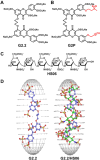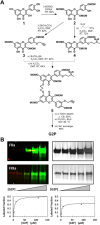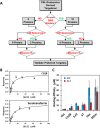This is a preprint.
A Robust Proteomics-Based Method for Identifying Preferred Protein Targets of Synthetic Glycosaminoglycan Mimetics
- PMID: 39896571
- PMCID: PMC11785238
- DOI: 10.1101/2025.01.23.634492
A Robust Proteomics-Based Method for Identifying Preferred Protein Targets of Synthetic Glycosaminoglycan Mimetics
Abstract
A robust technology is critically needed for identifying preferred protein targets of glycosaminoglycans (GAGs), and synthetic mimetics thereof, in biological milieu. We present a robust 10-step strategy for identification and validation of preferred protein targets of highly sulfated, synthetic, small, GAG-like molecules using diazirine-based photoaffinity labeling-proteomics approach. Our work reveals that optimally designed, homogeneous probes based on minimalistic photoactivation and affinity pulldown groups coupled with rigorous proteomics, biochemical and orthogonal validation steps offer excellent potential to identify preferred targets of GAG mimetics from the potentially numerous possible targets that cloud GAG interaction studies. Application of this 10-step strategy for a promising highly sulfated, small GAG mimetic led to identification of only a handful of preferred targets in human plasma. This new robust strategy will greatly aid drug discovery and development efforts involving GAG sequences, or sulfated small mimetics thereof, as leads.
Keywords: glycosaminoglycan-binding proteins; glycosaminoglycans; interactome; photoaffinity; proteomics.
Figures




Similar articles
-
Thrombopoietin mimetics for patients with myelodysplastic syndromes.Cochrane Database Syst Rev. 2017 Sep 30;9(9):CD009883. doi: 10.1002/14651858.CD009883.pub2. Cochrane Database Syst Rev. 2017. PMID: 28962071 Free PMC article.
-
Gender differences in the context of interventions for improving health literacy in migrants: a qualitative evidence synthesis.Cochrane Database Syst Rev. 2024 Dec 12;12(12):CD013302. doi: 10.1002/14651858.CD013302.pub2. Cochrane Database Syst Rev. 2024. PMID: 39665382
-
Technological aids for the rehabilitation of memory and executive functioning in children and adolescents with acquired brain injury.Cochrane Database Syst Rev. 2016 Jul 1;7(7):CD011020. doi: 10.1002/14651858.CD011020.pub2. Cochrane Database Syst Rev. 2016. PMID: 27364851 Free PMC article.
-
Alternative agents to prophylactic platelet transfusion for preventing bleeding in people with thrombocytopenia due to chronic bone marrow failure: a meta-analysis and systematic review.Cochrane Database Syst Rev. 2016 Oct 31;10(10):CD012055. doi: 10.1002/14651858.CD012055.pub2. Cochrane Database Syst Rev. 2016. PMID: 27797129 Free PMC article.
-
Systemic pharmacological treatments for chronic plaque psoriasis: a network meta-analysis.Cochrane Database Syst Rev. 2021 Apr 19;4(4):CD011535. doi: 10.1002/14651858.CD011535.pub4. Cochrane Database Syst Rev. 2021. Update in: Cochrane Database Syst Rev. 2022 May 23;5:CD011535. doi: 10.1002/14651858.CD011535.pub5. PMID: 33871055 Free PMC article. Updated.
References
-
- Perez S, Makshakova O, Angulo J, Bedini E, Bisio A, de Paz JL, Fadda E, Guerrini M, Hricovini M, Hricovini M, Lisacek F, Nieto PM, Pagel K, Paiardi G, Richter R, Samsonov SA, Vivès RR, Nikitovic D, Ricard Blum S. Glycosaminoglycans: What remains to be deciphered? JACS Au. 2023. Mar 2;3(3):628–656. - PMC - PubMed
-
- Capila I, Linhardt RJ. Heparin-protein interactions. Angew Chem Int Ed Engl. 2002. Feb 1;41(3):391–412. - PubMed
-
- Esko JD, Selleck SB. Order out of chaos: assembly of ligand binding sites in heparan sulfate. Annu Rev Biochem. 2002;71:435–71. - PubMed
-
- Vallet SD, Berthollier C, Ricard-Blum S. The glycosaminoglycan interactome 2.0. Am J Physiol Cell Physiol. 2022. Jun 1;322(6):C1271–C1278. - PubMed
Publication types
Grants and funding
LinkOut - more resources
Full Text Sources
